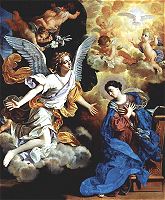
click to enlarge |
|
THE ANNUNCIATION
Benedetto Gennari
Italian, 1633-1715
S.N. 131, oil on canvas (100-1/2 x 82-3/4 in.)
From: "The Pages"
|
ARTIST:
Active in Bologna, where he trained in the studio of his uncle, Guercino (Giovanni Francesco Barbieri), one of the great Italian painters of the 17th century. From 1672 to 1674, Gennari worked at the court of Louis XIV. From 1674 to 1685 he worked in London in the court of Charles II.. He then worked for James II until he was dethroned in 1688. He died in Bologna in 1692.
SUBJECT:
The “Annunciation” represents the announcement by the angel Gabriel to the Virgin Mary that she would conceive and bear the Son of God, to be named “Jesus” (Luke 1:25-38). The Virgin has been interrupted while kneeling at a prie-dieu and reading a book of prayers. With her hands crossed in humility and with eyes downcast, Mary turns to the angel and listens to his astounding message. The lily symbolic of the Virgin’s purity, and the Dove of the Holy Spirit complete the elements usually found in all painters’ versions of the annunciation..
PAINTING (1686):
Gennari has anticipated the age of Rococo: the draperies and clouds make small curled patterns. Notice the hands and the use of blue paint. The hands and the blue become prevalent and are both emotion-provoking aids. Gennari reveals his own artistic identity in the refined, subtle colors, the complicated folds of the metallic draperies and the English or northern facial types. Bequest of John Ringling, 1936.
HISTORICAL CONTEXT:
This is Catholic counter-reformation art. The painting was commissioned by King James II of England for his new private chapel at Whitehall Palace, 1686. It was removed from the palace when Protestantism was restored as the official religion of England and the king was exiled to France in 1688.
Also read: Angels in Art
ringlingdocents.org
|